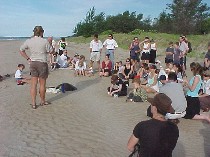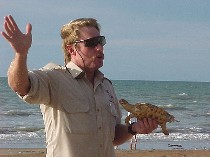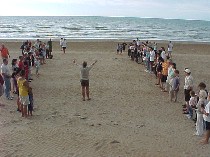Ocean Culture - People and the Sea
Activity 3: Be a Marine Conservation Scientist for a day
..
Aim: To provide children with an understanding of what is involved in being a marine scientist and the role they play in relation to the sea.
The group will be able to:
- Discover the types of tasks that a marine conservation scientist is involved in
- "Meet" a marine conservation scientist via a video
- Learn about turtle species, in particular their diet, size, location and threats to them
- Learn how to use a simple scientific key to identify a turtle
- View some preserved baby turtle specimens
- Make a turtle sighting fridge magnet
Level: This activity has been conducted with children from grade 4 through to grade 6. this can be adapted to other primary age levels.
Length: 1 1/2 hours
Equipment required
- Video of a discussion with a marine conservation scientist
- Television and video
- Turtle slides
- Slide projector and screen
- Turtle shells
- Numbered pieces of paper from 1 through to however many turtle shells are available
- Pens/pencils
- Answer sheets, enough for each group
- Rubbish fishing lines and plastic bags and rubbish collected from a local beach
- 2 clear jars, one with a preserved white' jellyfish specimen, the other with a white plastic bag
- Turtle key, enough for each person in the group, this was sourced from the Queensland Department of Environment and Heritage
- Turtle information to provide to the group to read
- Turtle observation recording sheet
- Magnets
- Colouring pencils
- Turtle template
- Labels with the contact number printed on them
Introduction
|
Explain that this month is very special as it is Seaweek! This is a time when people around Australia focus on the sea. Seaweek is organised by the Marine Education Society of Australasia (MESA) a group of people who are committed to helping people learn more about the sea and how we can care for it. This year the theme for Seaweek is Ocean Culture People and the Sea.
Ask the group what they feel the word culture' means, spend some time discussing this.
Explain the outline of the activity to the group and what they can expect from the activity.
The Parks and Wildlife Commission employs 407 people throughout the Territory. |

The talk begins |
This can be broken down into:
- Corporate Management (Human Resources, Training, Media) 33 staff
- Park Management (rangers, planners and managers) 166
- Scientific Services (conservation officers and scientists) 91 staff
- Territory Wildlife Park (zoo keepers and park guides ) 47 staff
- Alice Springs Desert Park (zookeepers, park guides) 45 staff
- Bushfire Protection 25 staff
Some of those staff are directly involved in researching the marine environment.
Now we are going to meet Ray Chatto, a Marine Conservation Scientist with the Parks and Wildlife Commission in Darwin and find out about the types of work that he is involved in.
Ask the group what they think a Marine Conservation Scientist does?
- conducts research in the field and then with the information collected uses this to help conserve/look after ecosystems, habitats and species
- Monitors marine fauna
- Writes reports and scientific research articles
- Talks to the public about the information that has been found, what they can do to help conserve marine environments
- Responds to sightings of marine fauna (eg whales/turtles) or reports of beached/deceased marine fauna
|
Meet Ray
..
Why did Ray decide to become a marine scientist?
|

Ray |
|
One of the areas that Ray focuses on is turtles.
We are going to investigate just like Ray does these fascinating marine reptiles.
Show the group a turtle shell and discuss:
- How to tell the difference between a turtle and a tortoise
- The carapace (top part of the shell) and plastron (bottom part of the shell)
- Use of its flippers
|

Ray in action |
Show the group the series of turtle slides including:
- Green turtles
- Flatback Turtles
- Loggerhead turtles
- Hawksbill turtles
- Leatherback turtles
- Olive Ridley turtles
- Map of NT nesting sites
- Turtle tracks
- Eggs
- Turtle hatchlings
- Threats to sea turtles
When Ray needs to identify a turtle species from either a live or dead specimen a key is available to be used.
Provide each person with a turtle identification key and work through it with them to ensure they understand how to use it and the terms used. Have your turtle specimens spaced at different locations around the room. Each turtle will have a number on it. You can either divide the group into smaller groups or the activity can be completed as an individual. Each person will need to work through the key to identify each turtle and write their answer on a sheet of paper.
Once the group has completed the identification, spend some time going through the answers. If the group came up with the wrong answer work through the key to show where they may have gone wrong.
So why is it so important to learn about turtles in the Top End?
(Watch the video to hear what Ray thinks.)
Ask the group what some of the reasons were. Discuss with the group what some of the threats are to turtles.
Show examples of:
Dogs, feral pigs, campfires, torches, street and building lighting can also affect turtles.
If possible collect some litter from a local beach where turtles are known to nest and show the group. Discuss which litter would have an effect on turtles and why. How can we help to reduce these threats to turtles?
|
What does Ray say about how the community can help to conserve turtles?
(Watch the video to find out.)
The group listens to what he has to say about how important it is for the community to learn about turtles, pick up rubbish and what we can do to help conserve them and their habitat.
The group can then make their own turtle sighting fridge magnet to take home. The magnet will have a number where they can contact Ray if they come across turtles on the beach. They are also provided with a turtle observation sheet to complete if they come across a turtle and some further information on turtles. |

Parting the seas |
|